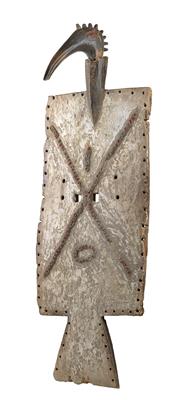Tussian (or Tusia), Burkina Faso: A rare, old plank mask ‘Loniake’.

The Tussian, a small tribe in the South of Burkina Faso, are famous for their plank masks, called ‘Loniake’ (or ‘Koniake’). They exist with birds heads and with buffalo horns (as a clan symbol). They are worn by young men during initiation rituals, in full-body costumes made of bark bast. The present ‘Loniake mask' is carved in light-coloured wood. It depicts a bird, probably the mythical ‘sacred’ Calao bird (hornbill). The head of the bird is executed with great precision: dyed black, with a long beak, a crest with eight projections, red-dyed eyes, with inserted red seed capsules (jequirity beans) as pupils. The entire bird’s head is attached to the similarly black-dyed neck. The frontal surface of the ‘Loniake mask' is coloured in white with kaolin and decorated with a geometric pattern (line, cross, circle). These lines are made of wax, with inserted red seed capsules (jequirity beans, some missing due to age). At the centre are two rectangular ‘peep holes’ through which the wearer of the mask can see. Two round holes for strings nearby for fastening the mask to the dancer’s head. A series of holes, in which long strings of bark bast were originally inserted, runs along the edge of the ‘Loniake’ mask until the end of the bird’s tail. This rare piece displays very good, old usage patina, especially on the reverse, and minor age damage (some pieces broken off on the edges and on the tail). First half of the 20th century; H: 102 cm, W: 36 cm. (ME)
Provenance: Private collection, Poland.
Literature: 'Tradition und Veränderung der Gesellschaftsstruktur bei den Tussian, Burkina Fasi' by Franz Trost, in 'Mitteilungen der Anthropologischen Gesellschaft in Wien', volume 129, 1999, p. 197-200, ill. p. 201; 'African Art in American Collections' von Robbins & Nooter, ill. 139 ('Loniake' with buffalo horns).
Additional photo:
The cover of the catalogue of the most important exhibition, ‘Primitivismus in der Kunst des zwanzigsten Jahrhunderts’ by William Rubin, 1996, depicts a Tussian ‘Loniake’ mask from the Musée Barbier-Müller, Geneva, comparable to the bronze ‘Vogelkopf’ sculpture by Max Ernst, 1934/1935.
Photo: Prestel Verlag
Esperto: Prof. Erwin Melchardt
 Prof. Erwin Melchardt
Prof. Erwin Melchardt
+43-1-515 60-465
erwin.melchardt@dorotheum.at
24.03.2014 - 16:00
- Prezzo realizzato: **
-
EUR 1.188,-
- Stima:
-
EUR 1.800,- a EUR 2.400,-
Tussian (or Tusia), Burkina Faso: A rare, old plank mask ‘Loniake’.
The Tussian, a small tribe in the South of Burkina Faso, are famous for their plank masks, called ‘Loniake’ (or ‘Koniake’). They exist with birds heads and with buffalo horns (as a clan symbol). They are worn by young men during initiation rituals, in full-body costumes made of bark bast. The present ‘Loniake mask' is carved in light-coloured wood. It depicts a bird, probably the mythical ‘sacred’ Calao bird (hornbill). The head of the bird is executed with great precision: dyed black, with a long beak, a crest with eight projections, red-dyed eyes, with inserted red seed capsules (jequirity beans) as pupils. The entire bird’s head is attached to the similarly black-dyed neck. The frontal surface of the ‘Loniake mask' is coloured in white with kaolin and decorated with a geometric pattern (line, cross, circle). These lines are made of wax, with inserted red seed capsules (jequirity beans, some missing due to age). At the centre are two rectangular ‘peep holes’ through which the wearer of the mask can see. Two round holes for strings nearby for fastening the mask to the dancer’s head. A series of holes, in which long strings of bark bast were originally inserted, runs along the edge of the ‘Loniake’ mask until the end of the bird’s tail. This rare piece displays very good, old usage patina, especially on the reverse, and minor age damage (some pieces broken off on the edges and on the tail). First half of the 20th century; H: 102 cm, W: 36 cm. (ME)
Provenance: Private collection, Poland.
Literature: 'Tradition und Veränderung der Gesellschaftsstruktur bei den Tussian, Burkina Fasi' by Franz Trost, in 'Mitteilungen der Anthropologischen Gesellschaft in Wien', volume 129, 1999, p. 197-200, ill. p. 201; 'African Art in American Collections' von Robbins & Nooter, ill. 139 ('Loniake' with buffalo horns).
Additional photo:
The cover of the catalogue of the most important exhibition, ‘Primitivismus in der Kunst des zwanzigsten Jahrhunderts’ by William Rubin, 1996, depicts a Tussian ‘Loniake’ mask from the Musée Barbier-Müller, Geneva, comparable to the bronze ‘Vogelkopf’ sculpture by Max Ernst, 1934/1935.
Photo: Prestel Verlag
Esperto: Prof. Erwin Melchardt
 Prof. Erwin Melchardt
Prof. Erwin Melchardt
+43-1-515 60-465
erwin.melchardt@dorotheum.at
|
Hotline dell'acquirente
lun-ven: 10.00 - 17.00
kundendienst@dorotheum.at +43 1 515 60 200 |
| Asta: | Tribal Art |
| Tipo d'asta: | Asta in sala |
| Data: | 24.03.2014 - 16:00 |
| Luogo dell'asta: | Wien | Palais Dorotheum |
| Esposizione: | 18.03. - 24.03.2014 |
** Prezzo d’acquisto comprensivo dei diritti d’asta acquirente e IVA
Non è più possibile effettuare un ordine di acquisto su Internet. L'asta è in preparazione o è già stata eseguita.
